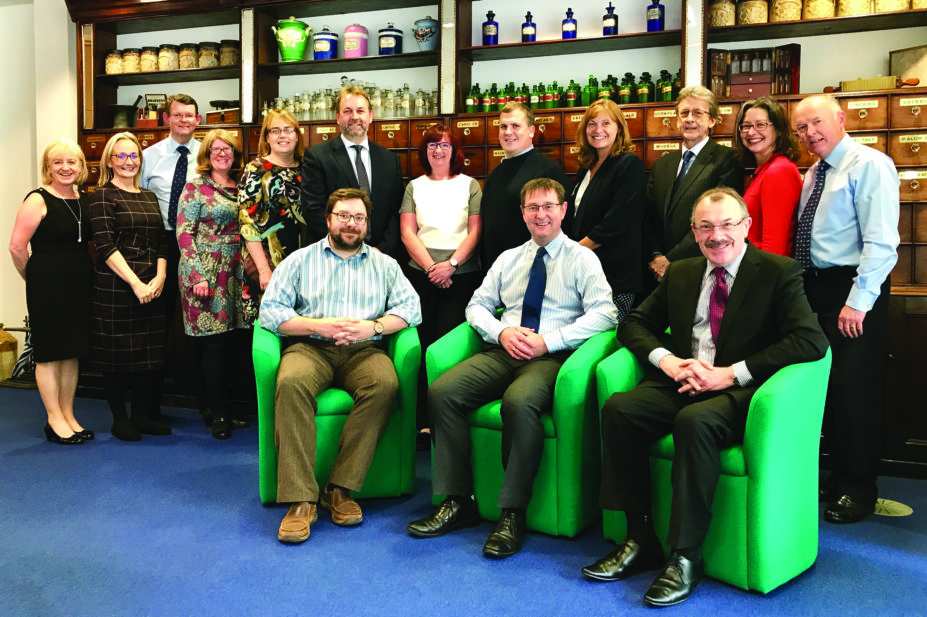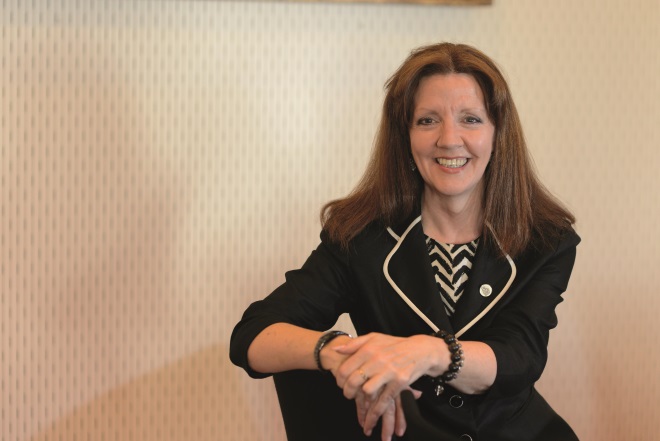
Susanne Cameron-Nielsen
The Scottish Pharmacy Board (SPB) held their autumn meeting at Holyrood Park House, Edinburgh, on 27 September 2017. Guests at the meeting included Rose Marie Parr, chief pharmaceutical officer for Scotland; Paul Bennett, chief executive of the Royal Pharmaceutical Society (RPS); Maurice Hickey, project policy pharmacist at RPS Scotland; Alan Timmins and Gary Cook, RPS representatives on the Scottish Intercollegiate Guidelines Network (SIGN) council, and Josh Miller, a third-year pharmacy student at the University of Strathclyde.
Addressing the board at the start of the meeting, Paul Bennett said he considered it hugely important that he was connected to the Society across the three nations and that in his first three months as chief executive he had been “blown away by the calibre of individuals in the Society”, who are “driven by the opportunity for the RPS to lead our profession”. Adding that it was clear to him that pharmacy is still underutilised, Bennett pledged that he and the executive team would provide more “clarity, certainty, direction and support” to RPS members and staff.
Business Plan
Updating the board on RPS Scotland’s business plan, Alex MacKinnon, director for Scotland, first thanked the RPS Scotland team for their work during his four-month secondment as interim chief executive.
Most objectives were up to date, MacKinnon said, with a small number of exceptions: the promotion of the RPS’s revised hospital standards, and contribution to development of community pharmacy standards, will now begin in quarter four of 2017. RPS Scotland’s contribution and influence to GB-wide activity on Faculty and Foundation frameworks, mentoring and leadership needs greater promotion, MacKinnon said, but capacity in the team is limited at the moment and this objective will be a priority for late 2017 through to 2018.
Aileen Bryson, practice and policy lead at RPS Scotland, said that on 19 September the Society had given oral evidence to the Scottish Parliament’s Health & Sport Committee consultation on the Draft Health and Sport Budget 2018. Susanne Cameron-Nielsen added that the RPS had discussed evidence at great length, and reminded the government that the Society can provide that in isolation from others.
SIGN
Alan Timmons and Gary Cook, RPS representatives on the Scottish Intercollegiate Guidelines Network (SIGN), made the case for more pharmacists getting involved with the network, which develops and shares evidence-based national clinical guidelines for best practice across multiple health and social care sectors.
Timmons and Cook said that pharmacists, as experts in the evaluation of evidence, could contribute a great deal to any guideline development groups looking at medicines-related matters. In their view, more engagement from pharmacists in SIGN’s guideline-development process would be valuable.
Discussing how to increase pharmacist involvement, board member Ann Boyter, who has been involved with SIGN for 12 years and is a member of the steering group for the SIGN/British Thoracic Society Asthma guideline, said she would talk to people and share her experiences. Until recently, Boyter said, she was the only pharmacist in this steering group.
Boyter said that in her view, the process-driven nature of SIGN work makes it ideal for pharmacists, and said that SIGN could put calls out for pharmacists to review papers, and these calls could be advertised through the RPS.
Annamarie McGregor, practice development lead at RPS Scotland, said the Society would explore how the critical appraisal skills that would be used in reviewing SIGN guidelines would fit into student and foundation year continuing professional development.
Rose Marie Parr
In the afternoon, board members were joined by Rose Marie Parr, Scotland’s chief pharmaceutical officer, who gave an overview of Achieving Excellence in Pharmaceutical Care – A strategy for Scotland. Parr talked the board through the nine commitments of the strategy, flagging priorities for the Scottish government.

Source: Simon Wright Photography / The Pharmaceutical Journal
Rose Marie Parr, Scotland’s chief pharmaceutical officer, said that people in remote and rural areas don’t get enough pharmaceutical care, and asked if innovations in IT could help address this
Parr pointed out that a lot of people in remote and rural areas don’t get enough pharmaceutical care, and added that some of these communities also experience deprivation. Parr asked if innovations in IT could, in part, address these issues.
Parr also said that the pharmaceutical profession needs to be more visible in Scotland: “People get medicines advice from their neighbour, their aunt, and the media. Where do pharmacists fit in?” Parr also said there was “work to do” around making better use of hospital pharmacists’ skills given that the average stay in hospital is now just 2.5 days, which, she said, doesn’t allow sufficient time for care planning.
Alex MacKinnon asked Parr whether it would be useful for the RPS to push members of the Scottish Parliament for better resourcing, to which Parr replied that politicians do listen to lobbying about what patients want: “Narratives around evidence-based outcomes will become important: the patient’s voice is what politicians hear”.
- The date of the next Scottish Pharmacy Board meeting was set for 17 January 2018.
You may also be interested in
Long service of members

Membership fees 2022
